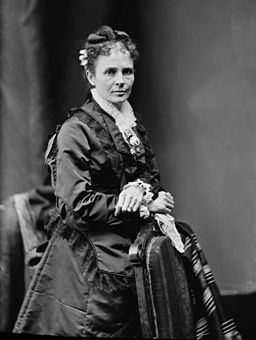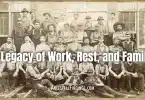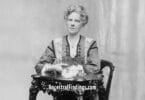James Abram Garfield (November 19, 1831 – September 19, 1881) was the 20th President of the United States, serving from March 4, 1881, to September 19, 1881. He is primarily remembered for being assassinated while in office, but Garfield was so much more than a historical footnote or bit of presidential trivia. He had impressive accomplishments before and during his brief presidency. Here is the story of the man behind the notation in the history books.
The youngest of five children born to Abram Garfield and Eliza Ballou, Garfield spent his childhood years in a log cabin, much like Abraham Lincoln only Garfield’s cabin was in Orange Township (now Moreland Hills), Ohio. Abram Garfield was from Worcester, New York, and followed his childhood sweetheart, Mehitabel Ballou, to Ohio when her family moved there. He intended to marry her but found her already married upon his arrival. Instead, Abram Garfield married Mehitabel’s sister, Eliza. Both Ballou sisters were born in New Hampshire.
Abram Garfield set up farming on the land where the little log cabin sat, with Eliza by his side. An older son, also named James, died as a baby, and the James who would become president was named after his older brother he never knew. Abram died in 1834 when James was only three years old, and he and his mother and older siblings lived in poverty in that cabin for some time. Eliza Ballou Garfield was a strong-willed woman, however, and she worked hard to give her children whatever she was able.
Eventually, Eliza remarried in 1842 to Warren Belden, but he proved an unsuitable husband to her and step-father to her children. She took her children and left him, and was granted an almost unheard of for the time divorce from him in 1850. James Garfield obviously never cared for his step-father, because when Belden died in 1880, James noted it in his diary with a tone of satisfaction.
Because of his poverty and the fact he had no father (as Eliza left Belden long before the divorce was actually granted), James Garfield was often teased by his fellow students and the other local boys in town. He made his escape from this annoyance by reading and became a voracious reader of everything he could get his hands on at a young age. He also took the first opportunity to leave town, going to Cleveland at age 16 in 1847 to look for work on the ships that sailed the Great Lakes.
The only ship in the harbor at the time rejected him, but Garfield was determined. He got work on a canal boat as a mule manager. Mules pulled the boat as it did its canal work, and Garfield was in charge of taking care of them.
James Garfield did not work on the canal boat long, however. He became ill after six weeks on it and was forced to go back home. While his mother was nursing him back to health, she made him promise to postpone going back to the boat until he had completed another year of schooling. As he promised her, he enrolled at Geauga Seminary in 1848, a school located in the nearby Chester Township.
Garfield later said he felt like he wasted the first seventeen years of his life due to having no money and no father to inspire him, and believed he would have accomplished much more by that age with both wealth and a father to back him up. But, he did finally find the inspiration he’d been searching for without knowing it when he enrolled in the school. He became an exemplary student and excelled particularly at languages and public speaking.
He worked his way through school by going from town to town as a teacher, which he disliked. He eventually found a permanent place teaching at Hiram College in Ohio and was allowed to teach while being a student there. While at Hiram, he re-encountered a young woman he’d met at Geauga, Lucretia Randolph. She had also enrolled at Hiram, and James tutored her in Greek. He already was attracted to her from their previous school, and their courtship began in earnest at Hiram.
Garfield finally enrolled at Williams College in Williamstown, Massachusetts, and was admitted as a third-year student, due to his previous work at other schools. He graduated as Salutatorian in 1856, then returned to Ohio to teach at Hiram as a full-time teacher. He was made the president of the college the next year.
He didn’t believe a career in education would allow him to reach his full potential or fulfill his interests, however. He married Lucretia Randolph in 1858 and eventually had seven children with her, five of whom survived childhood. Almost immediately after his wedding, he began studying law at Hiram and was admitted to the bar in 1861.

Mathew Brady [Public domain], via Wikimedia Commons
He was well known in the correct circles of society at this point, and the local Republican Party invited him to enter politics and was elected to his local Senate seat.
Garfield’s brand new political career was interrupted by the Civil War. He had become involved in the abolitionist cause, and enlisted in the Union Army without hesitation, even though he had no military experience. He was made a Major General and fought with his regiment at the battles of Middle Creek, Shiloh, and Chickamauga.
He was elected to Congress to represent Ohio’s 19th District in 1862, during the war, and gained a reputation as a skilled public speaker who supported a hard line against the South during Reconstruction (though he eventually changed his views to a more moderate approach to enforcing civil rights for the freed slaves of the former Confederacy).
Garfield became president quite by accident. He went to the 1880 Republican National Convention as campaign manager for John Sherman, who was then the U.S. Secretary of the Treasury. Garfield even gave a campaign speech for Sherman. However, Sherman and his rivals, who included Ulysses S. Grant, did not secure enough votes to be nominated for their party’s candidate. To his surprise, Garfield did. And, despite the fact he conducted a low-key campaign, he defeated Democratic rival Winfield Scott Hancock and became President of the United States.
Though his time in office was not long, he accomplished much, including enforcing presidential authority over the traditional courtesy given to the Senate in making executive appointments, increasing America’s Naval power, and cleaning up the corruption in the Post Office. He even appointed a Supreme Court justice. As president, Garfield supported innovating agricultural technology, educating the electorate, and enforcing civil rights for African Americans. In addition, he designed sweeping civil service reforms that were eventually signed into law by his successor, Chester A. Arthur, in 1883.
On July 2, 1881, Garfield was at the Baltimore and Potomac Railroad Station in D.C. when he was shot by Charles J. Guiteau. Guiteau was a lawyer and writer who had a personal grievance against him. The injury did not kill Garfield right away, and he resumed his presidential duties. However, his health became harder to maintain, as the doctors who treated the gunshot wound did not clean their hands when they did it. It led to an infection that ultimately killed Garfield on September 19, 1881. While Garfield is little remembered by historians for anything other than being assassinated while president, due to the short nature of his presidency, it is clear his accomplishments were many, and he deserves to be remembered as a great man in American history.








